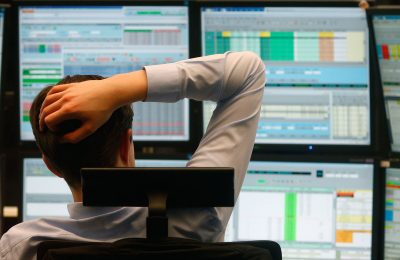Contents

This means, that if you were to get filled on a buy order at the market price, you would lose $2 if you sold immediately. Before we get into bid size vs ask size, let’s first review a few other important measures of option liquidity in financial markets. Remember, you only need to focus on the bid vs ask pricing at critical price levels and to gain a better understanding of how the security trades before investing your money. The one thing I will caution you against trading are low volume stocks with large spreads.

Each offer to sell similarly includes a quantity offered and a proposed sale price. The lowest proposed selling price is called the ask and represents the supply side of the market for a given stock. An order to buy or sell is filled if an existing ask matches an existing bid. Large firms called market makers quote both bid and ask prices, thereby earning a profit from the spread. The ask is the lowest price where someone is willing to sell a share.
By following this guide you should be sitting in a much better https://bigbostrade.com/ to be able to take advantage of this stock trading technique. If someone bids in a stock at £8.50 but a seller posts an ask price of £8.53, then the bid ask spread is £0.03. It is the literal difference between the bid price and the asking price. When assessing whether to buy or sell a stock, the bid price at that moment is your finite clue to the ‘auction’ price for that stock at that time. So a seller could immediately sell a stock at that price the moment a willing buyer for the shares emerges. Yes, with a limit order you can set the amount you’re willing to pay for the shares you want.
For starters, he could raise his limit order by 5 cents every day to see if the seller will come down on her bid price. Alternatively, if Dan was long and wants to sell, he could place a sell limit order at 49 cents – the top of the offer. If you recall from the first scenario, he shouldn’t place a market sell order as he’ll get filled at the bid price. One characteristic of high volatile environments are wide bid vs ask spreads.
In this video tutorial, Coach Matt goes through the latest edition of the Options Research Spreadsheet explaining how to use it to find the best stocks to cash flow. In this video tutorial, Coach T walks the team through how to set a basic stop on a covered call or naked put position. In this video, Coach Tim walks you through how to find candidates for bull put spreads. In this tutorial video, Coach T shows how to manage a credit spread and how to set up a contingency in ThinkOrSwim. I’m extremely determined to create a millionaire trader out of one my students and hopefully it will be you. I also encourage you to apply for the Trading Challenge.
Bid-ask spread
ASK for TP can be used for a quicker reaction to price movement — respectively, only on heavily liquid coins. And those where the spread does not exceed 1%, even on rapid price movements. The price at which the transaction closes will be closer to the target, since BID warrants are important for the sale on the market. As you remember, when tracking by BID, the transaction is more price sensitive. In the above example you can see the choices that you need to make in order to properly set up a Smart Trade order.
When the bid price and ask price are close together, the security has a greater liquidity. For new investors starting out, it is important to have a full understanding of the stock market. It is the gap or the difference between the bid price and the ask price. A higher spread indicates a wide difference between the bid and ask. It is usually difficult to make a profit with a bigger spread. A general rule is smaller the spread, the better the liquidity.
I could literally write a 5,000-word article on order types; however, I will keep things simple as the focus of this article is bid and ask prices. Conversely, if you are looking to sell immediately, you can enter your order in at the bid price. If you are a buyer and you must get in the position, you can simply accept the ask price and gain ownership rights to the security. To avoid this scenario, why don’t you run a test on the market? You can simply increase the buy limit price and decreasing the sell limit price by small increments. What Dan could do is enter a buy limit order at 31 cents.
Bid vs. Ask Price: How to Use It In Strategy Successfully?
Sadly you find yourself filled on the wrong side of the bid-ask spread. Slippage happens when you place market orders.To refresh your memory, if you’re placing a market order, you are telling your broker toimmediatelybuy or sell the stock for you atanyprice. Let’s look at a real life example of a stock with a bid vs. ask spread of $12.00-$12.02. You’re eager to get in, so you place a market order thinking you’ll get executed immediately at $12.00. The 20 EMA will work as dynamic support or resistance level in the buy trade. Moreover, the MACD histogram should be above the zero level in a buy trade and below the zero line for taking a sell trade.
- To avoid this scenario, why don’t you run a test on the market?
- However, by using different order types, traders can potentially avoid, or even exploit, the price difference caused by the spread.
- Managing a position is essential in trading and it’s important to understand the risks you face when using trailing stops.
- A deep understanding of bid and ask price is needed to make money from FX trading.
The size of the bid-offer spread is a measure of the liquidity of the market for that security, and also indicative of transaction costs. If the spread is zero then it is said to be a frictionless asset. A bid price is the highest price that a buyer is willing to pay for a good. This example of a limit order would work in reverse for a seller. If the current ask price is $12.05, they can set a limit order to sell once it reaches $12.10.
Its broker-dealer subsidiary, Charles Schwab & Co., Inc. , offers investment services and products, including Schwab brokerage accounts. Its banking subsidiary, Charles Schwab Bank, SSB , provides deposit and lending services and products. Access to Electronic Services may be limited or unavailable during periods of peak demand, market volatility, systems upgrade, maintenance, or for other reasons. Most free finance websites and tools will only equip you with delayed prices, although this is changing.
Is usually quoted low and is also designed so that the exact desired outcome is achieved. Since the seller will never sell at a lower rate, the asking price will always be higher. For example, if the asking price of a particular commodity is ₹2000 and a buyer is willing to pay ₹1500 for the same, he will quote an amount of ₹1000. It may look like a compromise, and both the parties will find a midway and agree to a price where they wanted to be from the beginning. Bid PriceBid Price is the highest amount that a buyer quotes against the “ask price” to buy particular security, stock, or any financial instrument. The below image quotes the bid and ask prices for a stock Reliance industries, where the total bid quantity is 698,780, and the total sell quantity is 26,49,459.
In a ‘https://forexarticles.net/er’s market,’ the seller makes the rules and that means buyers are paying up or getting left in the dust. Neither one of those terms necessarily is correlated to the bid/ask spread unless one of them trades and creates a “last price” print. Is it possible that it is the average of ALL the Bid/Ask prices, as seen in the Level II figures? As they constantly change, I took a screenshot and averaged the prices based on number of contracts and also without respect to the number of contracts.
Understanding The Practicality Of Buying And Selling- How To Get The Best Bid Price
There are some times of the day when the market you’re trading may not be moving much. If you want to sell, you’ll sell to the buyer that is offering the higher price . If you want to buy, you’ll purchase from the seller that is selling for the lower price .

Larger-priced stocks, indexes and ETF’s may have slightly larger spreads. If you trade options that have larger spreads, you run the risk of poor fill prices or volatile conditions opening the spread even further. The more volatile the options, the more likely the spread will open up to a large distance during certain economic events, at the market open or high periods of market volatility. You can still trade these options, but if you do, you need to learn how to execute limit orders and get good fill prices.
Options Greeks Guide Part 5: What Is Vega
If no orders bridge the bid-ask spread, there will be no trades between brokers. To maintain effectively functioning markets, firms called market makers quote both bid and ask prices when no orders are crossing the spread. In particular, they are set by the actual buying and selling decisions of the people and institutions who invest in that security. If demand outstrips supply, then the bid and ask prices will gradually shift upwards. The last price is the one at which the most recent transaction occurs, while the market price is whatever price the brokerage can find to fulfill your order as soon as possible. If you’re buying a stock, then the market price is the ask price at that moment.
Options 101: How to protect against earnings risk
The second is the highest rate that someone is willing to buy the currency from you. The first is the lowest rate that someone in the market is willing to sell you the currency. Timothy Li is a consultant, accountant, and finance manager with an MBA from USC and over 15 years of corporate finance experience. Timothy has helped provide CEOs and CFOs with deep-dive analytics, providing beautiful stories behind the numbers, graphs, and financial models. The High Fill Resolution feature will allow you to add a Tick series without any custom coding for the purpose of backtesting. You will not have to enter a BarsInProgress index in your trades to use this series.
The https://forex-world.net/ of a stock does not have anything to do with the bid-ask spread. A high volume stock like AAPL can have a much smaller bid-ask spread than a penny stock. Let’s say that the last price you saw was $100, the bid is $100, the ask is $101, and you order 100 shares market. In this case, your order probably gets filled for $101, which is $1 worse than you expected. This difference between the price you wanted to get and the price you finally got is called slippage.
